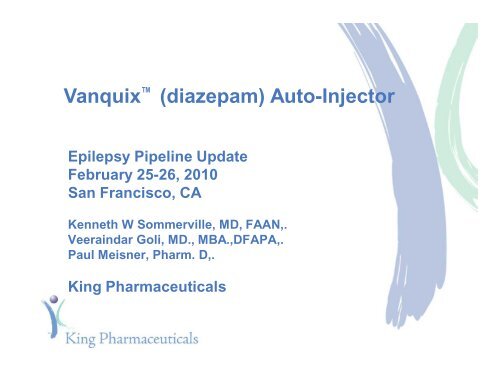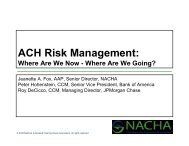Vanquix⢠(diazepam) Auto-Injector
Vanquix⢠(diazepam) Auto-Injector
Vanquix⢠(diazepam) Auto-Injector
You also want an ePaper? Increase the reach of your titles
YUMPU automatically turns print PDFs into web optimized ePapers that Google loves.
Vanquix (<strong>diazepam</strong>) <strong>Auto</strong><strong>Injector</strong><br />
Epilepsy Pipeline Update<br />
February 2526, 2010<br />
San Francisco, CA<br />
Kenneth W Sommerville, MD, FAAN,.<br />
Veeraindar Goli, MD., MBA.,DFAPA,.<br />
Paul Meisner, Pharm. D,.<br />
King Pharmaceuticals
How Does the <strong>Auto</strong><strong>Injector</strong> (<strong>diazepam</strong>) Work?<br />
• Based on <strong>diazepam</strong> 10 mg autoinjector used by US Army since 1991<br />
• Blue safety cap is removed; needle end is pressed firmly against<br />
outer thigh muscle (vastus lateralis)<br />
• Pressure triggers needle and plunger<br />
Needle gauge and length vary with dose<br />
• Needle fully extends and is held in place for 10 seconds<br />
• Entire dose (5, 10, or 15 mg) is delivered in less than 10 seconds<br />
2
What Are the Efficacy and Tolerability<br />
Characteristics?<br />
• Linear dose proportionality<br />
• Resolves 2 issues related to Diastat ®<br />
(<strong>diazepam</strong> rectal gel)<br />
Social issues<br />
Inconsistent blood levels<br />
• Overcomes historical problems with<br />
variable IM <strong>diazepam</strong> levels as vastus<br />
has less overlying fat than gluteal<br />
region<br />
• More stable platform for IM delivery<br />
than conventional syringe for<br />
administration to seizing patient<br />
• Side effects comparable to<br />
conventional intramuscular (IM)<br />
<strong>diazepam</strong><br />
Concentration (ng/mL)<br />
250<br />
200<br />
150<br />
100<br />
50<br />
0<br />
Mean Plasma Diazepam Concentrations<br />
0 5 10 15 20 25<br />
Time (hours)<br />
Vanquix 10 mg IM<br />
Diastat 10 mg PR<br />
Presented at: The American Epilepsy Society's Annual<br />
Meeting in San Diego 2006<br />
Available at: http://www.aesnet.org/go/publications/aesabstracts<br />
3
What Are the Development Challenges?<br />
• Overcoming historical inconsistency of standard<br />
<strong>diazepam</strong> IM<br />
• Human factor studies to optimize autoinjector<br />
• Ongoing phase 3 trial<br />
– Time for enrollment<br />
– Choice of patient population<br />
– Caregiver training<br />
– http://clinicaltrials.gov/ct2/show/NCT00319501?intr=<br />
%22Diazepam%22&rank=5<br />
4
What Are the Timelines and Milestones?<br />
1991<br />
U.S. Army use of<br />
<strong>diazepam</strong><br />
10 mg autoinjector<br />
2005<br />
Pharmacokinetic<br />
investigations<br />
2002<br />
King Acquired<br />
Meridian Medical<br />
Technologies<br />
2007<br />
Currently in phase 3<br />
Filing<br />
2012<br />
Marketing<br />
5
What Additional Indications Are Being<br />
Evaluated or Considered?<br />
• Acute ethanol withdrawal (detoxification)<br />
• Acute panic disorder<br />
• Acute agitation in psychiatric patients<br />
• Behavioral problems in emergency department patients<br />
• Ambulance and emergency medical technician use<br />
6
What Are the ValueAdded Propositions<br />
for Payors?<br />
• Greater precision for delivery of <strong>diazepam</strong> dose<br />
• Better control of ARS may lead to fewer secondary<br />
events, eg, trauma<br />
• Helps avoid acute repetitive seizures (ARS)<br />
epilepticus<br />
status<br />
• Reduction in emergency department visits for seizures<br />
• <strong>Auto</strong>injector may carry less potential for abuse than<br />
injectable <strong>diazepam</strong><br />
7

















